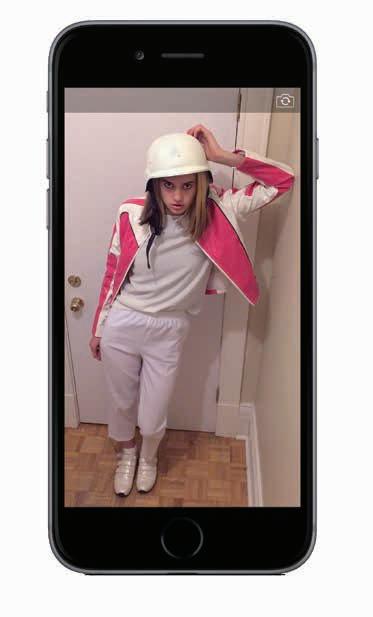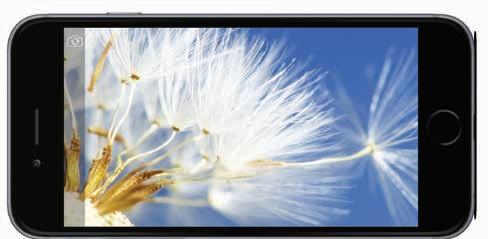
5 minute read
Tech Column
Credit: Simon Evers
Is Your iPhone Ready for Your Close-Up – or Wide Shot?
There’s been a huge buzz around the launch of the iPhone 6s and 6s Plus and not just because it’s the latest and greatest from the Apple lineup with its cult-like following. It’s the photographic upgrades that have captured attention, such as a front-facing 5 Mpixel Facetime HD sensor camera with a 12 Mpixel iSight sensor in the rear-facing camera. Behind all this is the A9 Apple Image Signal Processor which has accelerated performance of the cameras. There’s a complex explanation of how that works from Apple engineers which translates as: faster, cleaner, smoother and less noise. Bottom line: video captures up to 4K at 30 fps while 1080p is captured at 30 and 60 fps. Which brings up the question: why would a mobile device which is ostensibly used by the masses to post selfies and what they had for lunch need the hyper-crisp reality of 4K? Both Facebook and YouTube aren’t capable of running 4K clips and the upload process strips out quality. Even sharing peer-to-peer becomes problematic because of the file sizes. The answer is because Apple can, Apple does. Clearly, Apple is talking directly to filmmakers and potential filmmakers given the burgeoning wave of peripherals available: lenses from Olloclip and Moon Dog Labs, EnCinema adaptors that allow SLR lenses to be fitted, similar offerings from Turtleback, rigs from Camlite and Owle and editing software. Which leads to the neverending conversations among cinematographers: can you shoot a money job on an iPhone? And the answer is: Yes, no and why? Yes, the iPhone has already proved itself as a viable storytelling tool. There’s even competition not just between films, but also sites. Check out the features online at the upstart iPhone Film Festival site (www.iphoneff.com) and the Original iPhone Film Festival (iphonefilmmaker.com). Tangerine (youtu.be/ALSwWTb88ZU) directed by Sean Baker drew raves at Sundance and was shot entirely on an iPhone 5s. Cinematographer Luc Montpellier csc – no slouch with any technology over the last 21 years – notes we had the same debate when RED first appeared, then Blackmagic and then GoPro. Really it’s no different that whether back in the day we shot on Super 8, 16, 35 or 70 mm, each technology has its benefits and each will bring something to how the story is told. Of course, story always trumps
technology. At least it should. We caught up with Montpellier in Chicago where he’s DP on a Showtime production using ARRI ALEXA Minis, the superlight carbon fibre box which is adding a different dimension to the impressive ARRI lineup. “I shot a feature in Montreal using iPhones in 2013 called Happy Slapping,” he says. “I didn’t really have a lot to shoot. We put the iPhones in the actor’s hands and they shot it. I just gave them direction for the most part.” The point, he says, wasn’t to prove the iPhone as a viable capture tool. It was integral to the story which was about a group of five teens randomly “happy slapping” strangers and posting their iPhone captured antics on a website to gain notoriety. The iPhone and social media were at the heart of the story around which the characters move, just as The Blair Witch Project – something Happy Slapping has been favourably compared to – used 16 mm because it was part of the story. “The camp which thinks everything has to be on a professional camera is really missing the point about what we’re supposed to be doing as cinematographers, which is to find the right palette whether its an AR16 or an iPhone,” Montpellier says. “That’s the core of what we do as a DP, is to find that language with the director. I’m using the I don’t like modern lenses because they’re too sharp and real. This is a street level show so I got some vintage lenses from Panasonic from the 1960s. The glass is all good, just reset into contemporary housings and they’re great for the assistants to work with and they flare in a certain way and they give you that edge, that look.” As such, he says, putting a powerful creative tool in the hands of more people to tell more stories is part of the democratization of art and creativity. “It’s just one tool,” he says. “You still have to make decisions about the lighting, the framing, all those things.” Even when working with the bigger cameras, Montpellier says he sets up his Sony A7s to grab shots in parallel and the quality is almost indiscernible. Ultimately, it’s what happens in post that will have the final say. A few frames here from a GoPro or an iPhone can work if the editing touch is right and adds to the story’s perspective. “It’s just a tool in the toolbox, whether it’s a couple of cutaways or the whole show,” Montpellier says. “Captain America and the Avengers were using Blackmagics as crash cams and no one says anything.
YOUR LIGHTING DESERVES
TLC
LEDGO scores top marks on both the CRI (Colour Rendering Index) as well as the all-important TLCI (Television Lighting Consistency Index). Meaning, LEDGO lighting fi xtures deliver exceptional ‘quality of light’, making them ideal for demanding applications, including television and digital cinema production.

ALEXA Mini which is a handheld but I’ve always been annoyed by the debate over this. It should be about creativity. You have to get in the mindset of how these devices are set up and embrace how they photograph and use them.”
Ian Harvey is a Toronto-based journalist who writes for a va riety of publications and covers the technology sector. He welcomes feedback and eagerly solicits ideas at ian@pitbullmedia.ca
LED Fresnel Light
Pro Studio LED Video Light Panel Pro LED Video Light
Check out the new LED Fresnel, Pro Studio video light panels, and Slim softlight series at Vistek. Not only do these new LEDGO units outperform previous models in terms of output, power consumption and rugged build. They come equipped with built-in DMX, and WiFi that allows you to set up a lighting network so you can control all units using an App or remote.




